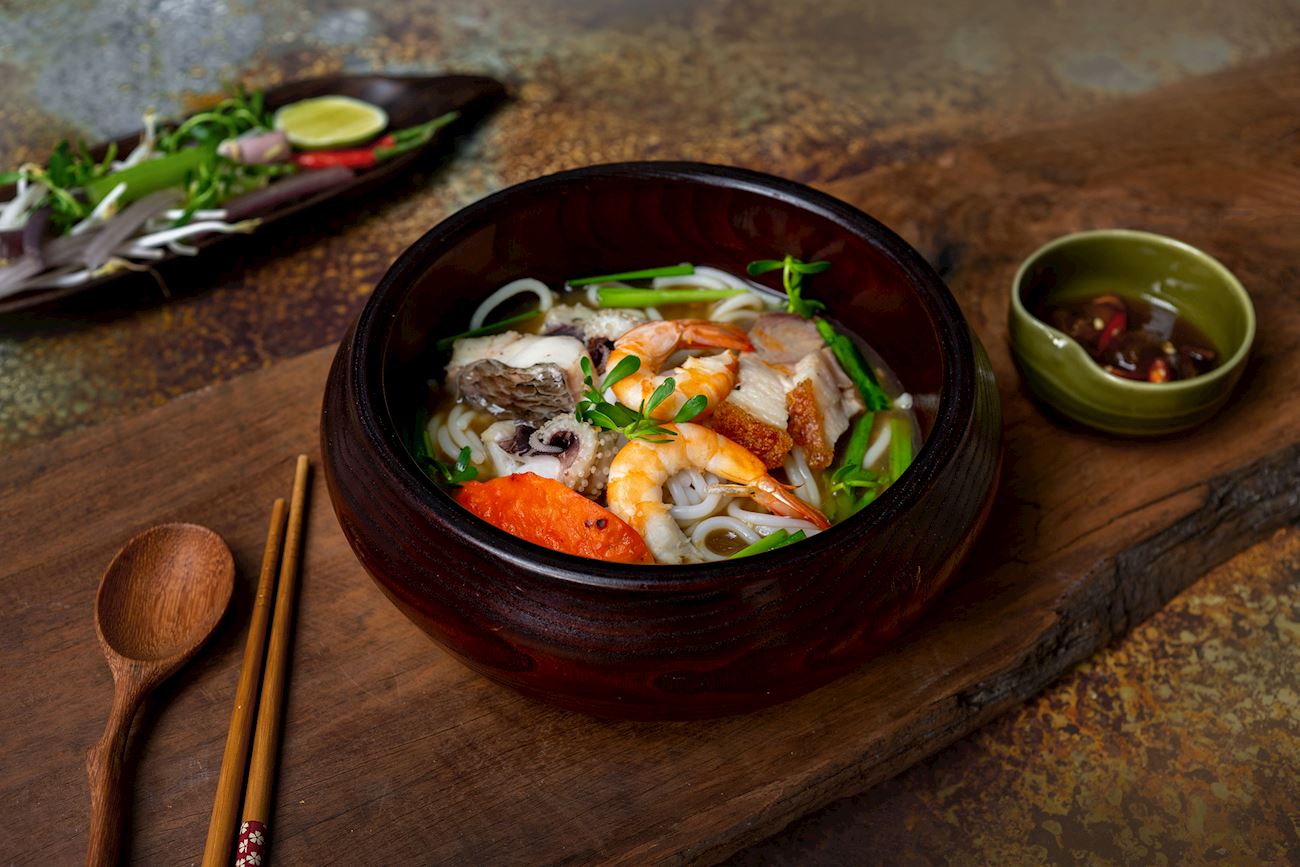This tangy snail soup is a staple in Hanoi. It is usually prepared with freshwater snails that are combined with a tomato-based broth. The dish also contains rice vermicelli noodles and fresh Vietnamese herbs, while typical garnishes include fish cakes, fried tofu, sliced scallions, fried shallots, or cilantro.
Lime wedges, shrimp paste, or chili sauce can be served on the side. Bún ốc is prepared as a classic winter version or as a refreshing summer variety in which the broth is served cold, and the noodles should be dipped in the broth and then consumed.
MOST ICONIC Bún ốc
View moreBún mắm is a traditional dish originating from the province of Soc Trang. The dish consists of bún rice vermicelli noodles, the murky, salty, and fermented fish-flavored mắm broth, squid, shrimp, catfish, eggplant (which soaks up the broth), fish cakes, and roasted pork belly.
Some of the most important ingredients include fresh herbs such as rau dang (bitter knotgrass), gia (bean sprouts), he (chives), bap chuoi (banana blossom), keo neo (yellow velvetleaf), rau nhut (water mimosa), and rau muong (morning glory). The aromas of bún mắm are very rich and often pungent.
VARIATIONS OF Bún mắm
Bún chả cá is a specialty of Da Nang and a traditional Vietnamese noodle soup topped with fish cakes. The broth for this noodle soup is traditionally prepared with fish or pork bones and tomatoes, while the fish cakes should be prepared from dense, meaty, and firm white fish fillets.
Other common ingredients in the soup include vermicelli noodles, fish sauce, shallots, garlic, cilantro, dill, mam tom shrimp paste, and black pepper. The hot broth is ladled over the noodles, and the dish is then topped with fish cakes. Bún chả cá is especially popular in seaside towns.
Bún mọc is a traditional noodle soup originating from Moc village, Nhan Chinh, Thanh Xuan, Hanoi. The main ingredients in the soup are vermicelli noodles and pork balls. The broth is usually made from shiitake mushrooms and pork ribs and bones, and the foam is skimmed off the surface regularly as the broth is simmering so that it remains clear and has a sweet, delicate, and rich flavor.
The pork balls are made from raw pork sausages such as cha lua, cha chien, cha la, and cha que. Bean sprouts, shallots, black pepper, and cilantro are welcome additions to bún mọc, elevating the noodle soup's flavors to make it even more rich.
Bánh canh is a traditional noodle soup. The thick noodles are made from tapioca or rice flour, while the soup is prepared with different kinds of ingredients such as ham (bánh canh gio heo), snakehead fish (bánh canh ca loc), or crab (bánh canh cua).
This noodle soup is usually thicker than other Vietnamese soups, and the consistency of the liquid is more similar to a gravy than a brothy soup. The base is typically made from pork bones or sometimes chicken, and it's seasoned with sugar, salt, and fish sauce.
VARIATIONS OF Bánh canh
MAIN INGREDIENTS
Canh chua is a popular Vietnamese soup originating from the Mekong Delta region. It's characterized by its contrasting flavors - sour, sweet, and savory. The soup incorporates ingredients such as seafood (eel, shrimp, snakehead, catfish), tomatoes, okra, pineapple, tamarind, bean sprouts, and fresh herbs with a tangy flavor.
Traditionally, canh chua is served either with rice vermicelli noodles or with a side of steamed jasmine rice. There are numerous versions of the soup depending on the ingredients used in it - besides fish, it can be made with water spinach, chicken, bamboo shoots, mustard greens, pork, or beef.
VARIATIONS OF Canh chua
MOST ICONIC Canh chua
View moreMAIN INGREDIENTS
This comforting chicken soup is a staple in many Vietnamese households. The base of the dish is a nourishing chicken broth that is typically flavored with lemongrass, charred onions, ginger, and fish sauce. The ingredients also include cellophane noodles (bún tàu), shredded chicken, shiitake mushrooms, and bamboo shoots.
A bowl of miến gà is sometimes garnished with sliced scallions, coriander, fried shallots, and fried chicken giblets, while typical accompaniments include lime wedges, fresh herbs, and chili peppers.
TasteAtlas food rankings are based on the ratings of the TasteAtlas audience, with a series of mechanisms that recognize real users and that ignore bot, nationalist or local patriotic ratings, and give additional value to the ratings of users that the system recognizes as knowledgeable. For the “7 Worst Rated Vietnamese Soups” list until May 18, 2025, 1,960 ratings were recorded, of which 1,379 were recognized by the system as legitimate. TasteAtlas Rankings should not be seen as the final global conclusion about food. Their purpose is to promote excellent local foods, instill pride in traditional dishes, and arouse curiosity about dishes you haven’t tried.





